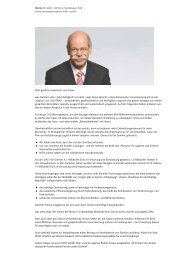Dear readers, This report describes what Daimler means by ...
Dear readers, This report describes what Daimler means by ...
Dear readers, This report describes what Daimler means by ...
You also want an ePaper? Increase the reach of your titles
YUMPU automatically turns print PDFs into web optimized ePapers that Google loves.
<strong>Daimler</strong> 360 GRAD - FAKTEN zur Nachhaltigkeit 2008<br />
<strong>Daimler</strong> Nachhaltigkeitsbericht 2008 / Environmental protection, innovation, and safety / Production / Energy and climate protection /<br />
Computation of CO 2 Emissions*<br />
Computation of CO2 Emissions*<br />
CO 2 emission values are calculated and presented in accordance with the standard of the GHG Protocol<br />
Initiative. ("A Corporate Accounting and Reporting Standard," rev. Edition, 2004, www.ghgprotocol.org). The<br />
organizational perspective includes all relevant majority holdings in their entirety (control approach), while the<br />
operational perspective takes into account all direct CO 2 emissions from stationary sources (Scope 1), as well as<br />
indirect emissions resulting from the generation of purchased electricity (Scope 2) and district heating.<br />
The emission factors utilized have in some cases been updated or adjusted in accordance with regional<br />
differences.<br />
Direct emissions from the combustion of heating oil, gas, and liquefied gas are calculated using fixed factors<br />
(WBCSD or DEHSt). With regard to coal, the factors that are employed in the calculation vary between Germany<br />
and the U.S.<br />
Indirect emissions resulting from the use of district heating and electricity are differentiated according to time<br />
and region when calculated with the GHG Protocol Initiative factors, provided more precise data is not available.<br />
The time axis of the German Heat and Power Association (AGFW) is used for the calculation of emissions from<br />
district heating in Germany, while the Institute for Applied Ecology's time axis is employed for calculating<br />
emissions from electricity production.<br />
In the U.S., the factors related to electricity production published <strong>by</strong> the EPA are applied to each individual state.<br />
In order to maintain a consistent time axis, these calculations are repeated each year for every industrial facility,<br />
even though this can result in differences between new figures and previously published data.<br />
Emissions of greenhouse gases other than CO 2 can not be calculated across the Group at this time. Calculations<br />
regarding climate-relevant coolants used at German plants do, however, reveal only a negligible portion in the<br />
parts per thousand range.<br />
Other indirect (Scope 3) CO 2 emissions stemming from the product utilization phase are expressed as specific<br />
vehicle emissions.<br />
* Content on this page is available exclusively on the Internet.














